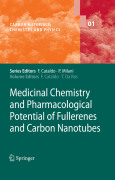
Medicinal chemistry and pharmacological potentialof fullerenes and carbon nanotubes
Cataldo, F.
Ros, T. da
Fullerenes and nanotubes are two classes of carbon structures or allotropes, which were discovered about 17 years ago. Since that time, many chemical derivatives have been synthesized using fullerenes and nanotubes as building blocks. Particularly promising was the theory that the chemical properties of fullerenes, and certain derivatives, made them likely candidates for anticancer drugs, inhibitors of viruses such as HIV, or even as anti-bacterials. Their cyctotoxicity can also be controlled by specific circumstances. In addition, the funtionalization of nanotubes has not only produced relatively simple derivatives, but also complex hybrids with biological macromolecules, which show unique supramolecular architecture and which are promising in many medical applications. The application of fullerenes and nanotubes in medicine is at the frontier of our knowledge, thus the work in this field represents the basis for future novel developments. First contributed volume to feature the recent developments which solely involve the pharmacological and biomaterials applications as well as the chemical properties of fullerenes INDICE: From the contents Twenty years of promises: Fullerene in medicinalchemistry.- Biomedical applications of functionalised carbon nanotubes.- Antioxidant properties of water-soluble fullerene derivatives.- Fullerenes as photosensitizers in photodynamic therapy.- Photodynamic inactivation of enveloped viruses by fullerene: Study of efficacy and safety.- Effects of photoexcited fullerene C60- composites in normal and transformed cells.- Biological effects in cell cultures of fullerene C60- dependence on aggregation state.- Gadolinium endohedral metallofullerene-based MRI contrast agents.- Biomolecules functionalized carbon nanotubes and their applications.- Applications of carbon basednanomaterials for drug delivery.- Visualization of carbon nanoparticles within cells and implications for toxicity.- The pharmacological applications of biocompatible carbon nanotubes and their emerging toxicology issues.
- ISBN: 978-1-4020-6844-7
- Editorial: Springer
- Encuadernacion: Cartoné
- Páginas: 500
- Fecha Publicación: 01/11/2008
- Nº Volúmenes: 1
- Idioma: Inglés
